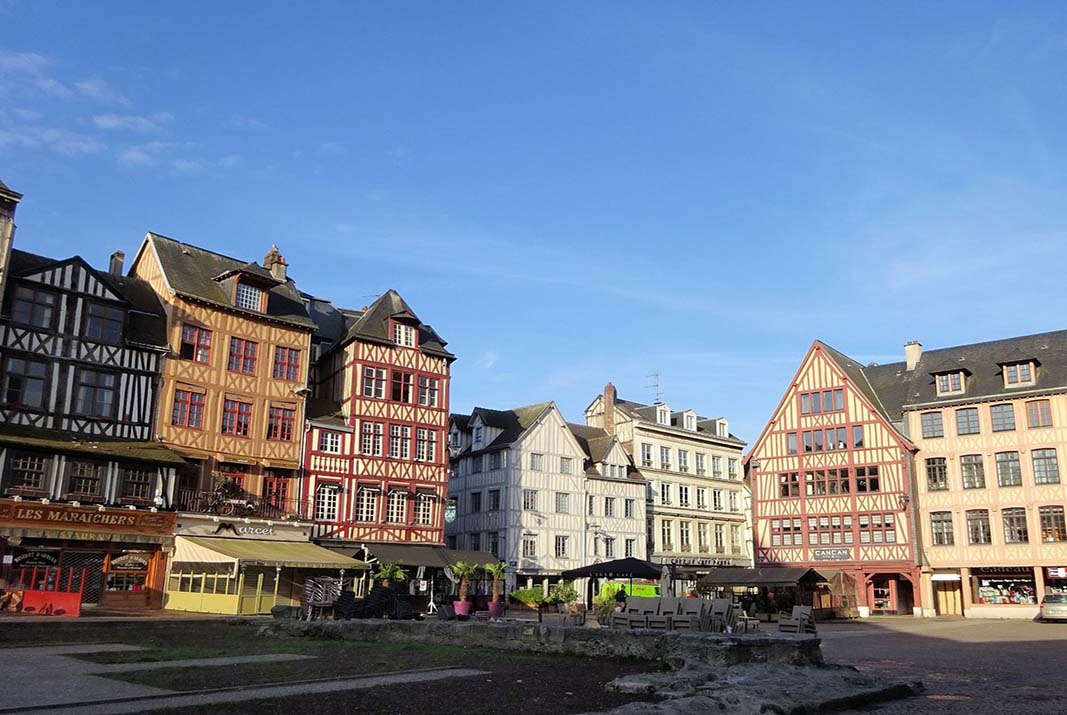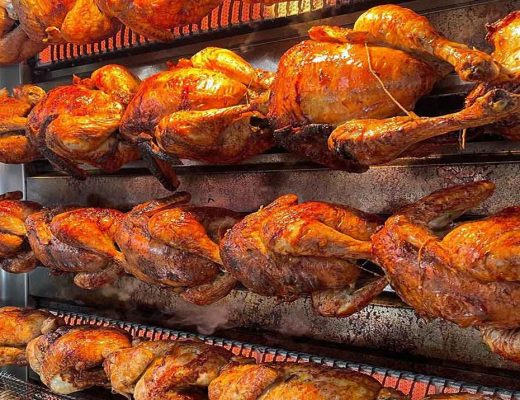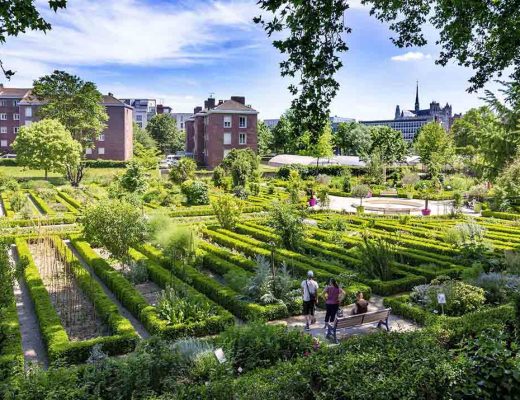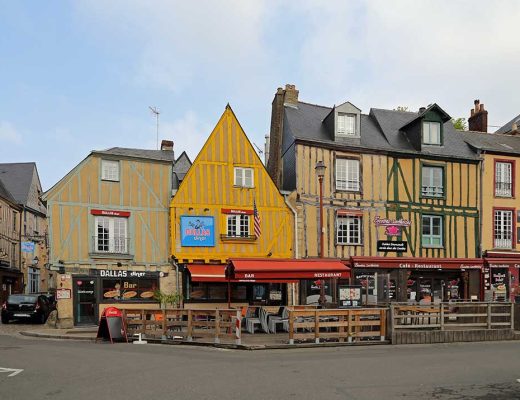When I first arrived in Rouen, the capital of Normandy, I felt as though I had stepped directly into a living painting. The cobblestone streets, the half-timbered houses leaning at improbable angles, and the Gothic spires cutting into the sky all seemed untouched by time. Paris had been grand and majestic, but Rouen carried a different charm—it was intimate, authentic, and deeply historical. Just walking through the old town felt like a passage through the centuries.
The train ride from Paris Saint-Lazare to Rouen Rive Droite station took just under two hours, and as I stepped off the platform, I knew I had entered a city where history breathes in every corner. I grabbed a local map, slung my bag over my shoulder, and began walking toward the old town, ready to lose myself in its medieval labyrinth.
The Heart of Rouen: Place du Vieux-Marché
My first stop was Place du Vieux-Marché, a square that is forever linked to the story of Joan of Arc. Located right in the center of Rouen’s old town, this square was once the place of bustling public markets where townspeople traded fresh produce, fabrics, and spices from distant lands. But it is also remembered as the tragic execution site of Joan of Arc in 1431. Standing there, I could almost hear the whispers of the crowd pressing closer, the crackling of the fire, and the courage of a young woman who refused to abandon her beliefs.
Today, the square has a completely different energy. Instead of hushed silence and fear, it is alive with cafés, restaurants, and flower stalls spilling color into the cobbled square. The aroma of roasting coffee beans drifts through the air, mixing with the sweet smell of fresh pastries. At its center stands the modern Church of Saint Joan of Arc, a striking structure with sweeping lines that resemble flames rising toward the sky. Its design, unconventional yet deeply symbolic, serves as a reminder of the fire that claimed Joan’s life.
Inside, the church is quietly beautiful. The stained-glass windows are among the most stunning I have ever seen, glowing with hues of ruby, sapphire, and emerald. They were salvaged from a 16th-century church destroyed during World War II, so when sunlight streams through, it feels as though fragments of Rouen’s past have been carefully stitched back together.
- Location: Place du Vieux-Marché, 76000 Rouen
- Entrance fee: Free to enter the square and church
- Best time to visit: Morning, before the cafés fill with crowds
- Booking tip: No booking required
I found a seat at one of the corner cafés, ordered a café crème and a slice of tarte normande, and watched as people crossed the square—locals heading to work, tourists pausing for photos, children chasing pigeons. The mix of everyday life with centuries of history gave me goosebumps. Eating here felt surreal. How many lives had unfolded in this very place? How many stories, both ordinary and extraordinary, had played out under the same sky?
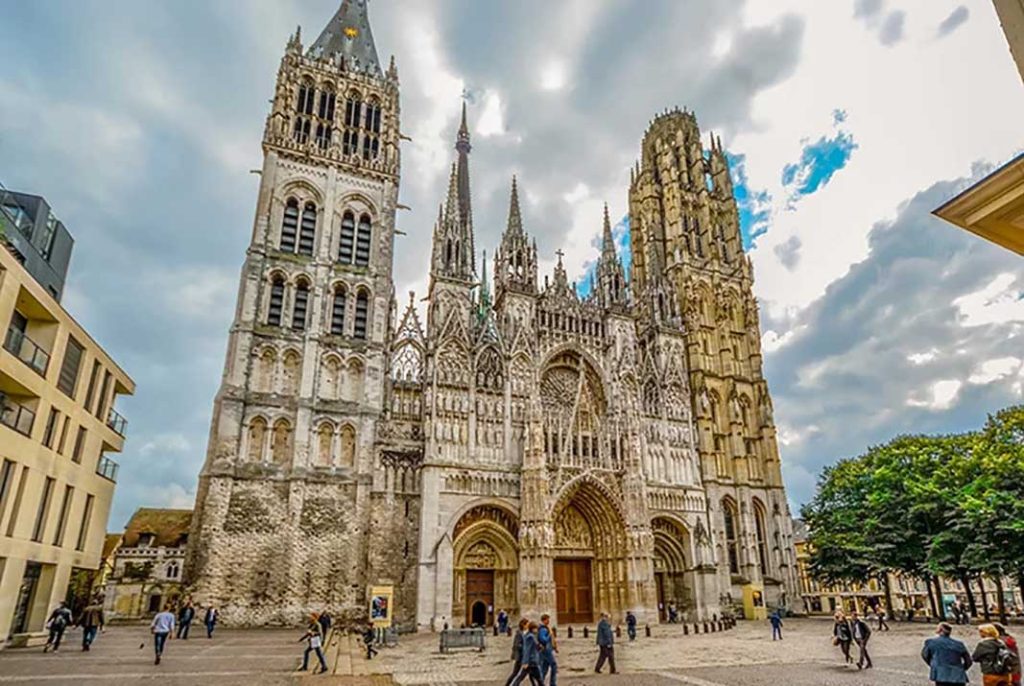
Rouen Cathedral: A Gothic Masterpiece
Nothing prepared me for the first glimpse of Cathédrale Notre-Dame de Rouen. As I turned a narrow corner onto Rue du Gros-Horloge, its façade suddenly appeared before me, like a grand curtain being drawn back at the start of a play. Towering 151 meters above the city, it was once the tallest building in the world during the 19th century. Even today, it dominates the skyline, a symbol of faith, resilience, and artistry.
The cathedral is a dazzling example of French Gothic architecture, and its façade alone could hold my attention for hours. Every inch is covered with sculpted figures and intricate stonework. Gargoyles peer down mischievously, while delicate spires seem to defy gravity. Standing before it, I felt dwarfed, not only by its size but by the craftsmanship of those who built it over centuries. It is no wonder Claude Monet painted this cathedral again and again, capturing how its face changed under shifting light. Seeing it myself, I understood his obsession.
Inside, the cathedral is vast and yet strangely intimate. Light pours in through stained glass, painting the stone columns with rainbow hues. The silence inside feels heavy but comforting, the kind of quiet that makes you instinctively lower your voice. One of the cathedral’s most fascinating treasures is the tomb of Richard the Lionheart’s heart—yes, only his heart. The rest of his body lies elsewhere, but his heart was brought here as a gesture of devotion to Normandy, his homeland.
- Location: Place de la Cathédrale, 76000 Rouen
- Entrance fee: Free, though guided tours may cost €10–€15
- Best time to visit: Late afternoon, when the golden sunlight illuminates the façade
- Booking platforms: Tickets for tours can be booked via GetYourGuide or Tiqets
What truly moved me was visiting in the evening for the son et lumière show. As the sun dipped and darkness fell, crowds gathered in the square, waiting. Then suddenly, the cathedral’s façade became a canvas for light and sound. Colors danced across the stone, telling the story of Rouen, its struggles, its triumphs, and its saints. Gasps echoed through the crowd as scenes shifted from fiery battles to serene, glowing stained glass. I felt as though the building itself was alive, whispering the history of Rouen across centuries. It was one of those rare travel experiences that makes you forget the present moment, pulling you entirely into the magic of place.
Gros-Horloge: The Golden Clock of Rouen
Strolling further down the cobbled Rue du Gros-Horloge, I reached the city’s iconic Gros-Horloge, a Renaissance astronomical clock housed in an archway that spans the street. Its golden face glimmered in the sunlight, framed by an elaborately decorated dial showing phases of the moon.
Walking beneath the arch feels like walking under a passage of time itself. For a small fee, you can climb up into the belfry for panoramic views over the old town and see the clock’s mechanisms up close.
- Location: Rue du Gros-Horloge, 76000 Rouen
- Entrance fee: Around €7 for the clock tower museum
- Opening hours: Tuesday to Sunday, 10 am–7 pm
- Tickets: Available on-site or through Viator
From the top, the view over Rouen was magical—timbered houses with red and white façades, narrow alleys filled with life, and the cathedral towering in the distance.
Saint-Maclou and Aître Saint-Maclou
Rouen is filled with Gothic churches, but Église Saint-Maclou is perhaps the most hauntingly beautiful. Located on Place Barthélémy, this flamboyant Gothic masterpiece is dedicated to Saint Maclou, the patron saint of plague victims. Its spire and arches are breathtaking, and though smaller than the cathedral, it has an elegance that feels almost otherworldly.
Nearby lies the Aître Saint-Maclou, a medieval ossuary that once housed plague victims. Today, it has been transformed into a cultural center, but the carved skulls and bones decorating the timber frame remind visitors of the Black Death that ravaged Europe.
- Location: Place Barthélémy, 76000 Rouen
- Entrance fee: Free for the church; €5–€7 for exhibitions at Aître Saint-Maclou
- Booking tips: No booking required for the church; cultural events can be reserved via Rouen Tourisme
Walking through the cloister, I felt a chill—an eerie reminder that Rouen has seen not only grandeur but also devastation.
Musée des Beaux-Arts de Rouen
After immersing myself in Gothic stone, I craved color and canvases. The Musée des Beaux-Arts de Rouen delivered beyond expectations. With works by Caravaggio, Monet, Delacroix, and Gericault, it is one of the finest regional museums in France.
The museum’s highlight is Monet’s series of paintings of Rouen Cathedral, displayed together in a room that feels like stepping into the painter’s vision. To see the cathedral outside and then its painted counterpart inside gave me a deep sense of how Rouen has inspired artists for centuries.
- Location: Esplanade Marcel Duchamp, 76000 Rouen
- Entrance fee: Free permanent collection; temporary exhibitions €5–€10
- Best booking platform: Tickets can be reserved via Fnac Spectacles
Wandering the Half-Timbered Streets
The joy of Rouen lies not only in its monuments but in its streets. I spent hours wandering aimlessly through alleys like Rue Saint-Romain, Rue Eau de Robec, and Rue Damiette. The timber-framed houses lean so close they almost kiss above the street. Many are painted in bright colors—red, green, yellow—and their crooked beams tell stories of centuries past.
Boutiques sell Norman cheese, antique books, and handcrafted souvenirs. Bakeries tempted me with tarte normande and buttery croissants. I ducked into a small creperie, ordered a galette filled with ham and melted cheese, and paired it with Normandy cider. That meal cost less than €12, and yet it felt priceless.

Costs, Booking Tips, and Platforms I Used
Rouen is wonderfully affordable compared to Paris. Most churches are free to enter, museums rarely exceed €10, and dining can range from budget-friendly crêperies to Michelin-starred restaurants. For tickets and reservations, I relied on:
- GetYourGuide (guided tours and cathedral light show tickets)
- Tiqets (museum entries)
- Trainline (train tickets from Paris to Rouen)
- Booking.com (hotels in Rouen; I stayed in a half-timbered guesthouse for under €90 a night)
- LaFourchette/TheFork (restaurant reservations, often with discounts)
For travel insurance, I booked through Allianz Travel, which gave me peace of mind during my trip.
Practical Tips for Visiting Rouen
- Best time to visit: Spring (April–June) or early autumn (September–October) when crowds are fewer and weather is pleasant.
- Currency: Euro (€)
- Language: French, though many people speak basic English in tourist areas.
- Getting around: The old town is compact and best explored on foot. Public transport is available but rarely necessary.
- Average daily cost: €70–€120 depending on meals and accommodations.
My Reflections in the Old Town
As I wandered back toward the train station at the end of my stay, the bells of the cathedral rang out across the rooftops. Rouen had given me more than sights—it had given me feelings. The weight of history, the resilience of a city that survived wars and plagues, and the quiet beauty of its streets stayed with me.
Walking in Rouen is walking inside history’s embrace. Every corner, every beam of wood, every stained-glass window whispers stories. It is not just a visit—it is an encounter with time itself.
